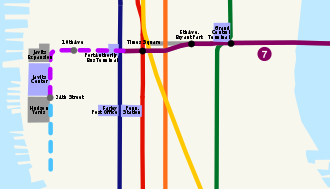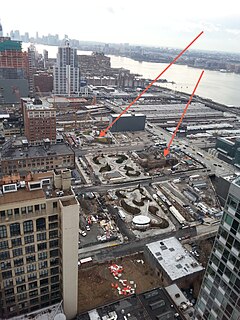7 Subway Extension
In response to the CPC's 1993 proposal to improve access to the Manhattan Central Business District,[3] the Metropolitan Transportation Authority (MTA) began exploring the possibility of a 7 extension to New Jersey.
[11] Mayor Michael Bloomberg's December 12, 2006, address to the New York League of Conservation Voters noted that in November 2006, the government began issuing bonds to fund the extension of the 7 subway to Eleventh Avenue and 34th Street.
[13] In October 2007, the Metropolitan Transportation Authority (MTA) awarded a $1.145 billion contract to build 7,000 feet (2,100 m) of twin-tube tunnel from the 7 train's then-terminus at Times Square to the then-planned shell of the 34th Street–Hudson Yards station.
[21][22] On December 3, 2007, the MTA conducted a ceremony at the Times Square subway station marking the launch of construction of the 7 train extension.
[23] One physical hindrance to the construction of the extension was the lower-level platform at 42nd Street–Port Authority Bus Terminal on the IND Eighth Avenue Line.
The two boring machines dug parallel 7,100-foot (2,200 m) long tunnels north along Eleventh Avenue to the current terminus of the 7 service at 41st Street and Times Square.
[38][39] Soon after Bloomberg's ceremonial ride, the opening date of the subway extension was postponed from June to early fall 2014,[40] then to November 2014,[41] then to February 2015,[42] and then to May 2015.
[42] On October 1, 2014, the MTA told the New York Daily News that the agency had signed a new agreement with the prime contractor, offering up to $4.75 million in incentive payments if the new station was finished and ready to open to the public by February 24, 2015.
[45] Just two and a half months later, though, the MTA stated that it was unable to open the subway extension for service until April to July 2015, due to the failure to get the inclined elevators to work properly.
[49][50] The use of inclined elevators was intended to provide wheelchair-using patrons with a shorter, easier path to the train platform, as well as to reduce tunneling costs.
[40] The MTA said the manufacturer chose to use American subcontractors in place of local Italian suppliers after reading the specifications the transit agency submitted.
[57][58][59] The MTA says that the new station will "make it possible for new housing, restaurants and entertainment to grow" in the surrounding neighborhoods, including Hell's Kitchen and Chelsea.
[68] In February 2009, the MTA announced that it would build the station if the agency received sufficient funds from the federal economic stimulus package.
[69] In June 2010, the city announced it was seeking funding to assess the feasibility of constructing the station at a later date using a two-platform, two-entrance model without an underground connecting passage.
[84] In 2010, The New York Times reported that Mayor Michael Bloomberg's administration had been considering an extension to Hoboken and to Secaucus Junction in New Jersey, allowing commuters from that state to more easily access Grand Central Terminal and other subway routes.
[88][89][90] On February 2, 2011, the city's Economic Development Corporation voted to budget up to $250,000 for a feasibility study of the proposed New Jersey extension, carried out by engineering firm Parsons Brinckerhoff.
[91][92] Amtrak's February 2011 announcement of the Gateway Project, which entailed two new commuter rail tunnels under the Hudson River, included a proposal to extend the 7 service three blocks east of Eleventh Avenue to New York Penn Station, instead of five miles west to Secaucus.
[93] Congress allocated $15 million for studies for the project in November 2011, with the likelihood that Gateway and the subway extension would be in competition for funding.
[94] In April 2012, citing budget considerations, the director of the MTA, Joe Lhota, said that it was doubtful the extension would be built in the foreseeable future.
[95] After the Parsons Brinckerhoff feasibility study was released in April 2013,[96][97] Bloomberg said: "Extending the 7 train to Secaucus is a promising potential solution ... and is deserving of serious consideration.
[100] In 2017, a further extension of the 7 train to New Jersey was suggested once again, this time as an alternative to constructing a replacement for the Port Authority Bus Terminal.
[102] In February 2018, it was revealed that the Port Authority had advertised for consultants to write an 18-month feasibility study for such an extension, and that it had received bids from several companies.
[104][105] At the time, the Port Authority was upgrading the PATH system, the only rapid transit link between New York and New Jersey, to accommodate more frequent trains.
For the first time in the world, a ground freezing method was used to harden soil to act as rock to allow TBMs to maintain proper course while boring and placing the tunnel liners.




